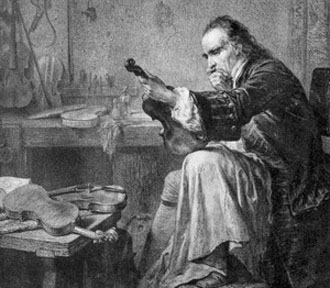By Andy Fein, Luthier, Fein Violins, Ltd.
Stradivarius. So much of my life is wrapped around learning what he did, how he did it, and maybe even why he did it. Sometimes when I'm working on an instrument, I feel like I'm having a conversation with Stradivarius. Partly with words and partly with the way I work a piece of wood for a violin. Here are some things you may or may not know about him.
1. He was a real person. Antonius Stradivarius lived in Cremona, Italy. He was born in 1644 and died in 1737. That's 93 years! An extremely long life for someone living in the 17th and 18th centuries.
2. He likely learned his craft in the Nicola Amati workshop and worked for Amati for several years.
3. At about age 16 he began putting his own labels in his instruments while he still worked for Amati. He would continue to work in the Amati workshop into his thirties.
4. He was married twice and had ten children. Of those ten children, only two (but possibly three) of his children became violin makers. Those two were Omobono and Francesco Stradivarius. There's an obscure son, Giovanni Battista Martino Stradivari, that probably worked in the family workshop, was an outstanding luthier, but died at age 24 in 1727. Very little is concretely known about Giovanni but much research is being done!
5. Antonius Stradivarius and Antonio Stradivari are the same person. The first spelling (Antonius Stradivarius) is his formal Latin name, the second spelling (Antonio Stradivari) is the more common Italian name.
6. A third son, Paolo, was a cloth merchant, but managed the business end of the Stradivari family workshop after Antonius' death.
7. Stradivarius worked on violins right up until the year of his death, 1737. Probably all of them were made with the help of Omobono, but they're still considered "Stradivaris"!
8. Over his lifetime, Stradivarius made more than 1,000 instruments. Of those, about 650 survive. Most of the surviving instruments (over 500) are violins.
9. Like most other artists of all mediums, Stradivarius had different periods. His best period, from 1700 to 1720 is known as his "Golden" period.
10. Stradivarius made his instruments to the Baroque standard of the time. Almost all Stradivarius violins have had their necks replaced with a longer neck and have a new bass bar inside. The Messiah Stradivarius is one of the few violins that has not been altered.
 |
| A scroll by Stradivarius |
1. He was a real person. Antonius Stradivarius lived in Cremona, Italy. He was born in 1644 and died in 1737. That's 93 years! An extremely long life for someone living in the 17th and 18th centuries.
2. He likely learned his craft in the Nicola Amati workshop and worked for Amati for several years.
 |
| An early Stradivarius violin, made circa 1679, showing the influence of Amati |
3. At about age 16 he began putting his own labels in his instruments while he still worked for Amati. He would continue to work in the Amati workshop into his thirties.
4. He was married twice and had ten children. Of those ten children, only two (but possibly three) of his children became violin makers. Those two were Omobono and Francesco Stradivarius. There's an obscure son, Giovanni Battista Martino Stradivari, that probably worked in the family workshop, was an outstanding luthier, but died at age 24 in 1727. Very little is concretely known about Giovanni but much research is being done!
5. Antonius Stradivarius and Antonio Stradivari are the same person. The first spelling (Antonius Stradivarius) is his formal Latin name, the second spelling (Antonio Stradivari) is the more common Italian name.
6. A third son, Paolo, was a cloth merchant, but managed the business end of the Stradivari family workshop after Antonius' death.
7. Stradivarius worked on violins right up until the year of his death, 1737. Probably all of them were made with the help of Omobono, but they're still considered "Stradivaris"!
 |
| Andy Fein holding a Stradivarius made in 1737, the year of Stradivari's death. |
8. Over his lifetime, Stradivarius made more than 1,000 instruments. Of those, about 650 survive. Most of the surviving instruments (over 500) are violins.
9. Like most other artists of all mediums, Stradivarius had different periods. His best period, from 1700 to 1720 is known as his "Golden" period.
 |
| The 'Messiah' Stradivarius, 1715-16 |
10. Stradivarius made his instruments to the Baroque standard of the time. Almost all Stradivarius violins have had their necks replaced with a longer neck and have a new bass bar inside. The Messiah Stradivarius is one of the few violins that has not been altered.
 |
| 'The Messiah' © Pruneau / Wikimedia Commons / CC BY-SA 3.0 |
Are you a violinist or interested in becoming one? Take a look at our Fine Violins!



No comments:
Post a Comment